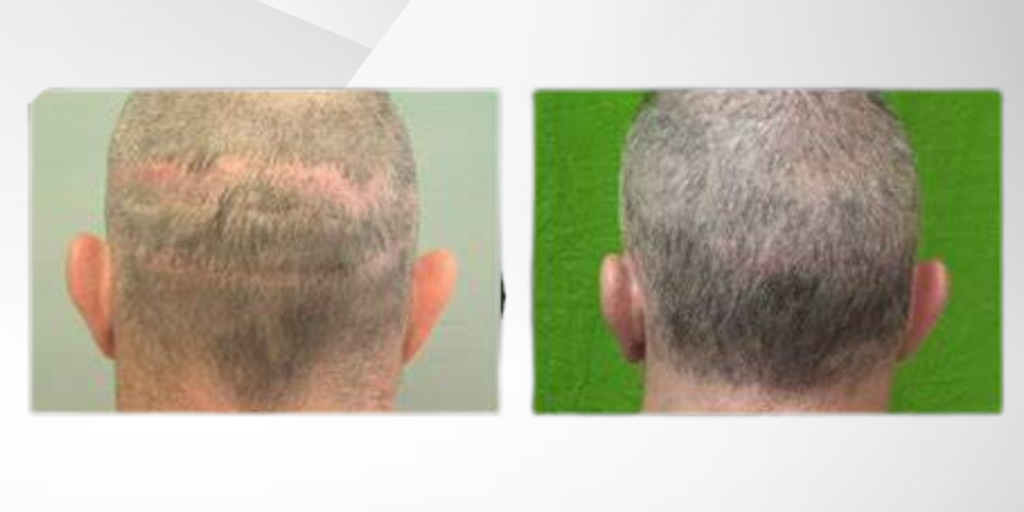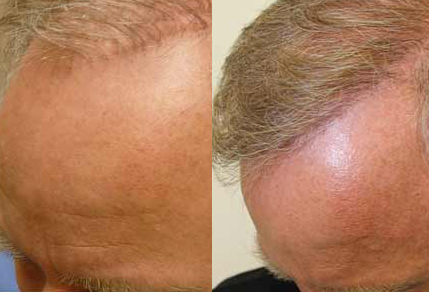Get personalized Consultation!
Revision Hair Transplantation
At Vida Skin and Hair Transplant Clinic, we understand the importance of achieving the best possible results for our patients. This is why we offer revision hair transplantation, a specialized procedure that aims to correct previous hair transplant surgeries that may not have met expectations. Our team of experts is highly skilled and experienced in performing revision hair transplantations, using the latest techniques and state-of-the-art equipment to ensure optimal results.
Types of Revision Hair Transplantation
There are different types of revision hair transplantation, depending on the specific needs and circumstances of each individual. These include:
- Scar revision: This type of revision focuses on correcting and minimizing the appearance of visible scars left by previous hair transplant surgeries. Using advanced techniques such as follicular unit extraction (FUE), our surgeons carefully extract individual hair follicles from the donor area and transplant them into the scarred areas, creating a more natural and seamless result.
- Density improvement: In some cases, patients may not be satisfied with the density achieved in their initial hair transplant surgery. Revision hair transplantation can address this issue by adding additional hair grafts to increase the overall density and fullness of the hairline or other desired areas.
- Correction of unnatural hairline: If the previous hair transplant resulted in an unnatural-looking hairline that does not match the patient’s facial features, revision hair transplantation can help to create a more aesthetically pleasing and harmonious hairline. Our skilled surgeons carefully design and create a new hairline that complements the patient’s facial characteristics.
What are the steps and stages for Revision Hair Transplantation?
Revision hair transplantation involves several steps and stages to ensure the best possible outcome. Here is a breakdown of the typical process:
- Consultation: The first step is to schedule a consultation with one of our experienced hair transplant surgeons. During this consultation, the surgeon will evaluate the patient’s specific concerns and goals, assess the condition of the previous hair transplant, and determine the best course of action for the revision.
- Preparation: Prior to the surgery, the patient may be advised to avoid certain medications or activities that could interfere with the procedure or recovery process. The surgeon will provide detailed instructions to ensure optimal preparation.
- Donor hair extraction: Depending on the technique chosen (FUE or follicular unit transplantation), the surgeon will carefully extract donor hair follicles from a suitable donor area, typically the back or sides of the head. The hair follicles are then prepared for transplantation.
- Recipient area preparation: The surgeon will prepare the recipient area, ensuring that it is clean and ready for the transplantation of the extracted hair follicles. This may involve making tiny incisions or slits to accommodate the grafts.
- Hair follicle transplantation: The prepared hair follicles are meticulously transplanted into the recipient area, following the surgeon’s design and technique. Great attention is given to the placement and angulation of each graft to achieve natural-looking results.
- Post-operative care: After the surgery, patients will receive detailed instructions on how to care for the transplanted hair, including washing, avoiding certain activities, and taking any prescribed medications. Regular follow-up appointments will also be scheduled to monitor the progress of the hair growth and address any concerns.
What to Expect During Revision Hair Transplantation
During the revision hair transplantation procedure, patients can expect to experience a comfortable and relatively painless process. Local anesthesia is used to numb the donor and recipient areas, ensuring minimal discomfort throughout the surgery. Depending on the complexity of the revision, the procedure can take several hours to complete.

How is the hair growth after the transplant?
Following the revision hair transplantation, the newly transplanted hair follicles will undergo a shedding phase, where the hair shafts fall out. This is a natural part of the hair growth cycle and should not cause concern. After the shedding phase, new hair growth will gradually start to emerge within a few months.
It is important to note that the timeline and rate of hair growth can vary from person to person. Some individuals may experience faster hair growth, while others may experience a slower progression. Patience is key, as it can take up to a year to see the full results of the revision hair transplant.

Tips for the patient after revision hair transplant
To optimize the results of the revision hair transplantation and ensure a smooth recovery, patients should follow these tips:
- Follow post-operative instructions: It is crucial to carefully follow the post-operative instructions provided by the surgeon. This may include avoiding strenuous activities, refraining from scratching or picking at the transplanted area, and taking prescribed medications as directed.
- Protect the transplanted area: It is important to protect the transplanted area from excessive sun exposure or trauma. Wearing a hat or using sunscreen can help prevent damage to the newly transplanted hair follicles.
- Maintain a healthy lifestyle: Good overall health is beneficial for hair growth. Eating a balanced diet, staying hydrated, exercising regularly, and managing stress can contribute to optimal results.
- Be patient: Hair growth is a gradual process, and it is important to be patient during the recovery period. Avoid comparing the progress to others and trust in the expertise of your surgeon.
Benefits and Risks of Revision Hair Transplantation
Revision hair transplantation offers several benefits for individuals who are unsatisfied with the results of their previous hair transplant surgery. These include:
- Improved appearance and natural-looking results
- Minimization of visible scars
- Increased hair density and fullness
- Correction of an unnatural hairline
However, like any surgical procedure, there are some risks involved. These can include infection, bleeding, scarring, and the potential for suboptimal hair growth. It is essential to choose a reputable and experienced hair transplant clinic, such as Vida Skin and Hair Transplant Clinic, and closely follow the post-operative care instructions to minimize these risks.
Preparing for Revision Hair Transplantation
To prepare for revision hair transplantation, it is important to schedule a consultation with a qualified hair transplant surgeon. During this consultation, the surgeon will evaluate the patient’s specific concerns and determine the best course of action for the revision. It is important to provide accurate information about any previous hair transplant surgeries and any medications or medical conditions that may affect the procedure.
Aftercare and Recovery from Revision Hair Transplantation
After the revision hair transplantation, proper aftercare and recovery are essential to optimize the results. This includes following the post-operative instructions provided by the surgeon, attending follow-up appointments, and practicing good scalp hygiene. It is important to be patient during the recovery process, as it can take several months to see the full benefits of the revision hair transplant.
Do's and Don'ts
To ensure a successful revision hair transplantation, here are some do’s and don’ts to keep in mind:
Do’s:
- Follow the post-operative instructions provided by your surgeon.
- Protect the transplanted area from sun exposure and trauma.
- Maintain a healthy lifestyle to support hair growth.
- Attend all follow-up appointments and address any concerns with your surgeon.
Don’ts:
- Don’t scratch or pick at the transplanted area, as this can disrupt the healing process.
- Don’t compare your progress to others, as hair growth varies from person to person.
- Don’t neglect scalp hygiene, as keeping the scalp clean and healthy is important for optimal results.
- Don’t hesitate to reach out to your surgeon if you have any questions or concerns during the recovery process.
With the right approach and a skilled surgeon, revision hair transplantation can provide a solution for individuals who are dissatisfied with the results of their previous hair transplant surgery. By following the guidelines provided by the surgeon and practicing patience during the recovery process, patients can achieve natural-looking and satisfying results that enhance their overall appearance and confidence.
At Vida Skin and Hair Transplant Clinic, we are committed to helping our patients achieve their desired hair restoration goals through our expertise and personalized approach.
Frequently Asked Questions!
Revision Hair Transplantation is a surgical procedure performed to address unsatisfactory results or complications from a previous hair transplant. It involves correcting issues such as uneven hair distribution, unnatural appearance, or insufficient hair density.
Individuals who have undergone a previous hair transplant and are dissatisfied with the results or have experienced complications may be candidates for Revision Hair Transplantation. A consultation with a qualified surgeon is crucial to assess the specific concerns and determine candidacy.
The optimal time to consider Revision Hair Transplantation varies, but it is generally advisable to wait until the results of the initial transplant have fully matured. This could take anywhere from several months to a year.
Common reasons include dissatisfaction with the aesthetic outcome of the initial transplant, uneven hair growth, scarring, or changes in the patient’s hair loss pattern that necessitate further correction.
Revision procedures can be more complex due to factors such as scar tissue from the previous surgery. However, experienced surgeons specializing in revisions are skilled in addressing these challenges to achieve improved results.
Yes, Revision Hair Transplantation can address issues with a poorly designed or unnatural-looking hairline. Surgeons can strategically place hair follicles to create a more natural and aesthetically pleasing hairline.
Risks include infection, scarring, and the possibility of continued dissatisfaction. Choosing a qualified and experienced surgeon is crucial to minimize these risks and achieve a successful outcome.
Recovery time is similar to that of the initial hair transplant, typically requiring a week for most individuals to resume regular activities. Post-operative care instructions are vital for optimal healing.
Yes, depending on the specific circumstances, patients may have the option to choose a different hair transplant method during the revision to address the issues encountered with the initial procedure.
While Revision Hair Transplantation has a high success rate, complete success cannot be guaranteed. The outcome depends on factors such as the surgeon’s skill, the patient’s individual circumstances, and the complexity of the revision needed.